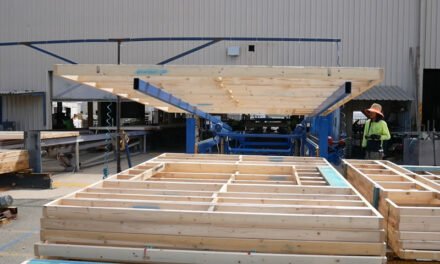With a few watchpoints in mind, LVL can be a valuable part of your timber truss design arsenal. By Afzal Laphir, Principal Engineer, Meyer Timber Pty Ltd
Laminated veneer lumber, more commonly known as LVL, needs no introduction, having made its mark over many years of use in Australia as a high-strength, dimensionally stable, reliable and low-cost engineered alternative to sawn timber.
Recently, there has been considerable discussion regarding LVL compliance, especially with the entry of new suppliers into the market. As a result, a number of publications and articles pertaining to this subject have emerged, including an EWPAA/FTMA technical alert, the Meyer Timber factsheet on LVL compliance and recent feature articles in this magazine. That being the case, this article will steer away from compliance and focus on the things to look out for when using LVL in trusses – as well as discuss the properties that matter.
STRENGTH AND STIFFNESS PROPERTIES
The characteristic properties of LVLs are not listed in Australian standards (unlike MGP, F-grades, and glulam). Each LVL supplier is responsible for providing the specific properties of their product, determined in accordance with AS/NZS 4357.0. Its non-standard nature means the property values of LVL can vary between different suppliers, even if they have a similar branding (e.g. LVL14, E14, etc).
When LVL is intended for a specific use, only the properties relevant to that particular application need to be determined and published. For example, if LVL is to be used as beams and lintels, the minimum properties required are the Modulus of Elasticity (E value), bending, shear and bearing, along with the joint strength of nails, screws and bolts.
However, if the LVL is intended for use in trusses, three additional properties must be determined, namely compression, tension and the joint strength of nailplates.
NAILPLATE PROPERTY
Of these additional properties, the nailplate property or the tooth-holding capacity requires special emphasis as it is influenced by a number of factors, including the veneer characteristics (eg: species, thickness, grain direction etc) of the LVL and its production. This results in very different values between suppliers whether the nailplate is pressed into the face or edge of the LVL.
It should be noted that the tooth-holding capacity is dependent on how the teeth are orientated to the grain of timber and the direction of force, which is different to conventional joints using screws or nails. The nailplate property is also dictated by the method of truss fabrication, depending on whether a platen or roller press is used.
Given the many influential factors as discussed above, rigorous testing of the nailplates is essential. This testing process is carried out by each nailplate company using their proprietary nailplates on a given LVL, to determine the specific tooth-holding capacity for the different conditions. As there are multiple variations to the test regime, it may take several months to complete.
The results of these tests then need to be incorporated into the proprietary software of the respective nailplate companies, which can also take a few months, depending on the release cycles of the software.
SUBSTITUTION: BEAM VS TRUSS
For beams or lintels, the primary design focus is on their ability to resist bending. In such applications, the design is limited typically by deflection or stiffness. The ‘E’ value (Modulus of Elasticity) becomes a crucial parameter as it influences the beam’s stiffness. As a result, in beams and lintels, substitution of LVLs from one supplier to another can normally be achieved following a simple design check, provided their ‘E’ values are similar.
On the other hand, in truss chords, the design is subjected to a combination of axial forces (tension or compression) along with some bending and shear forces. The interaction between bending and axial loads is usually critical in such cases. Additionally, the variation in nailplate properties adds another layer of complexity to the design. This means in trusses, substitution of LVLs from one supplier to another is not straightforward and must not be done for any member without further assessment.
LVLs of a similar E value may have more pronounced variations in their bending, compression, or tension strength properties, and such differences can be exacerbated under combined actions. So, if replacing one LVL with another in this type of application (see Figure 1, main image above), a full truss re-design is required.
LVL IN FLOOR TRUSSES
LVL can also be used in floor trusses, as top and bottom chords, provided the necessary assessments have been made and are available for use in the proprietary software offered by the nailplate company. Firstly, the characteristic ‘on-flat’ properties must be established which are often lower for bending and shear than the on-edge values. As illustrated in Fig 2 (below), the peak bending forces of an on-flat member are concentrated on the outer veneers unlike in a standard roof truss ‘on-edge’ application where the forces are evenly distributed across all veneers. Secondly, the nailplate properties need to be determined for teeth embedded into the edge of LVL.

BENEFITS OF LVL
LVL offers numerous advantages over sawn timber, making it an ideal choice for truss applications due to its dimensional stability, high strength, wide sections, and long lengths. In truss design, the combined strength actions of bending and compression (or tension) take precedence over the E value. LVL’s superior strength properties, as compared to sawn timber (refer Table 1, below), allow for more efficient design of truss members.

An example of a typical 6m-span girder truss demonstrates how LVL E15 can lead to reduced section sizes when compared to sawn timber, resulting in cost savings. Importantly, LVL E15 retains a 90mm top chord, ensuring the plumb depth (heel height) remains consistent with the rest of the roof. The section sizes in Table 1 are based on the girder truss supporting 6m standard trusses and a concrete tile roof in the N2 wind region.
Similar to the E value, the influence of the nailplate property of an LVL is also overshadowed by the strength properties. Even if the tooth-holding capacity of nailplates varies between LVLs, the design differences and associated cost variations in a girder truss remain relatively small. Heel plates and splices in such trusses are often governed by steel strength, which remains independent of the LVL being used. Therefore, the superior strength properties of LVL are the primary factors driving its advantageous use in trusses.
The benefits of LVL have made it a commonly available building material in Australia and we need to relay the message of using it properly. Builders become complacent and with limited knowledge have started to adopt the “same, same” attitude. Whilst substitution in beam applications can be done with a simple design check, if a Frame & Truss plant is designing LVL in trusses then only the designed LVL can be used. Any changes must only be done after a full re-design. The attitude adopted here should be “not same, not same, and different”.
For more information, visit https://ftmanews.com/wp-content/uploads/FTMA-Tech-Alert-LVL-Compliance.pdf and https://meyertimber.com.au/wp-content/uploads/MT_Factsheet_LVLCompliance.pdf
For more detail on this topic, contact Afzal Laphir via email at AfzalL@meyertimber.com.au
(Main image) LVL used as the bottom chord of a truncated girder truss.












